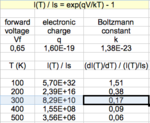bhl777
Full Member level 6
Hi All, I am trying to use a diode connected circuit from https://en.wikipedia.org/wiki/Log_amplifier.
From it we can see the final equation is this

However, I have a question about Is0. From other literature, this saturation current is also a function of temperature, so the question here is:
If I want to write a equation of Ic(T), is the temperature coefficient of Is0 can be negalected? Can we treat this Iso as a constant compared with the change of e(Vbe/Vt) over a range of temperature?
For example, now I want to compare the Ic at 200K and 350K, can I say the difference of them are mainly come from e(Vbe/Vt) but not from Is0(T)?
Thank you very much!
From it we can see the final equation is this
However, I have a question about Is0. From other literature, this saturation current is also a function of temperature, so the question here is:
If I want to write a equation of Ic(T), is the temperature coefficient of Is0 can be negalected? Can we treat this Iso as a constant compared with the change of e(Vbe/Vt) over a range of temperature?
For example, now I want to compare the Ic at 200K and 350K, can I say the difference of them are mainly come from e(Vbe/Vt) but not from Is0(T)?
Thank you very much!


